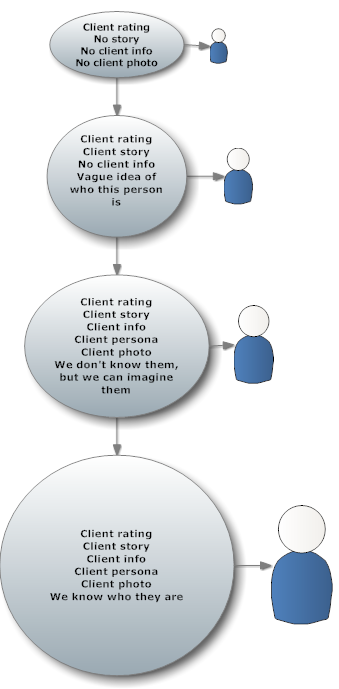When writing on the web about your services or products, I can’t emphasize enough the importance of testimonials and client reviews. Social proof is such a strong persuasion trigger you shouldn’t limit these comments to just a page, but have them scattered throughout your web and blog pages.
Know what works best for your content marketing strategies, especially when creating a website or blog, introducing yourself, a new product, or special promotion.
In my previous post, Social Proof: Why It’s So Important, I reported on research that showed travel destinations with client recommendations and photos of the reviewer were selected 20 percent more than destinations with no review.
But not all recommendations (and ratings) will yield the same results. According to Dr. Susan Weinschenk, in her book Neuro Web Design: What Makes Them Click:
- We are most influenced when we know the person and the person is telling a story. But quite often, it’s unlikely we will actually know a person doing an online review, unless they are a well-known author or respected expert in the field.
- We are somewhat less influenced when we don’t know them, but we can imagine them because there is a name, a company name, a link to their site, and maybe a persona description of them (like, for example, a stay-at-home mom, a runner, a CEO, a Ph.D.)
- We’re even less influenced when we don’t know the person, can’t imagine them, but we are at least provided with a story.
- We are least influenced when we don’t know the person and we’re only provided with a rating.
Here’s another way of looking at the degree to which a client recommendation will work to convince readers to take action:
Clearly, there are advantages in sharing as much as possible about the reviewer leaving a rating or comment. For example, a persona might include a description of the reviewer such as “A patent attorney,” or “a work-at-home parent,” or, “a daily tennis player.” Photos and links to web pages that tell about the person are ideal.
I think the worse are the ones with just initials, like R.M., or Robert M. It’s as if they are hiding the identity for fear you’ll try to contact them.
What I recommend to clients who have been using initials to keep client identities anonymous, (as in the case of therapists or lawyers, for example,) is to provide some identifying characteristics such a profession and approximate age: “R.M., a 40-year-old software developer,” or, “R.M., a middle-aged successful blogger.” The key is to provide enough information that the reader can imagine a person and their circumstances, without specifics, or too much information to give their identity away.
I’ll share more about that in my next post, along with other tips when faced with the challenge of gathering ideal testimonials from clients.
















Recent Comments